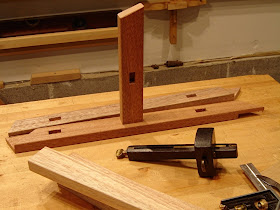If you are like me, you have favorite tools, and this little plane is one of mine. It's a Sargent 106 block plane and it has just about everything I find pleasing in a tool: functionality, style, and a connection to the past.
It may or may not be "collectible", but I'm a user! Besides, what kind of life would it be sitting on a shelf, watching all the other planes make shavings? And this plane is a really good performer too. It doesn't have a tight mouth, it's non-adjustable, it doesn't have a low angle iron, but it is a plain-old, straight-up, worker. And at just under 5 1/2 inches, I can use it one handed without worrying about dropping it.

Style wise, I love how this plane looks. The "gull-wing" screw on the lever cap is just cool!

I'm not sure where this plane came from - I look for old tools EVERYWHERE. I think I found it in a junk/antique store in Redmond, Oregon. I'd love to know how many others used it before me, and on what projects. At least one of them left his or her mark on it. If you look carefully (you might need to click to enlarge) you can make out what looks like "TED" but is actually "T.E.B" scratched into the cheek of the plane. On the other cheek is what looks like a Social Security number (not shown). I'd love to know more about T.E.B.

I'd also like to know how old this plane is. I think it is on the older side, but I don't have enough information to be sure. Here's the little I know. I haven't seen many of the "gull-wing" style 106's in the wild or on the bay, which makes me think it is on the old side. It doesn't have the VBM logo which Sargent used something like 1910 - 1918. But is this pre or post VBM? The logo on the iron is an oval, with "Sargent & Co. New Haven, CT" surrounding a sort of double arrow design. Here's a closer shot of the logo:

If anyone has any information about Sargent 106 block planes, Sargent logos, or knows any good online sources of information, I'd appreciate hearing about them. For that matter, any information on a woodworker from central Oregon with the intials T.E.B. would be great too :)




















